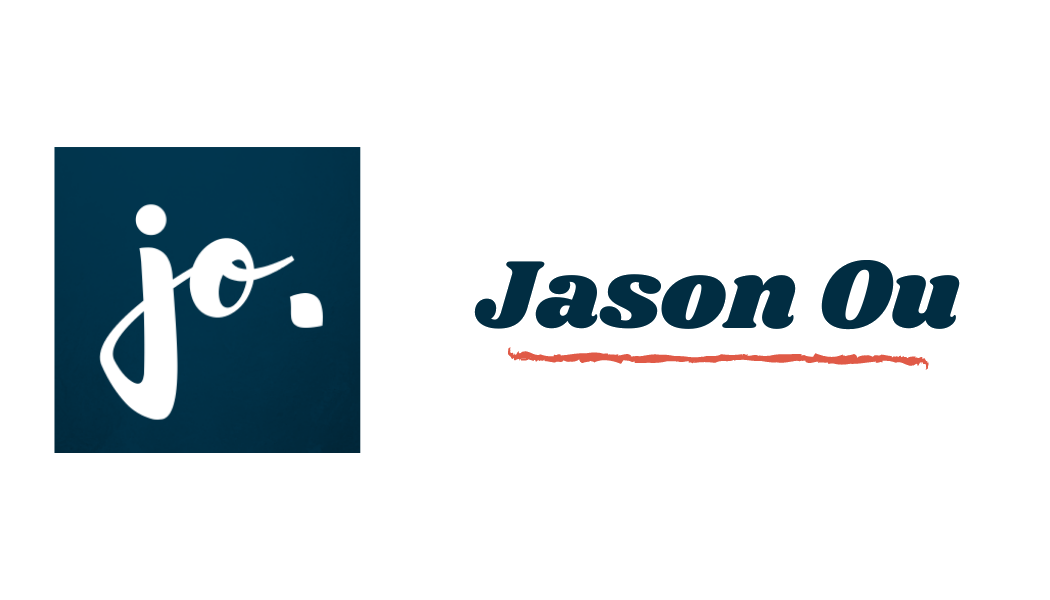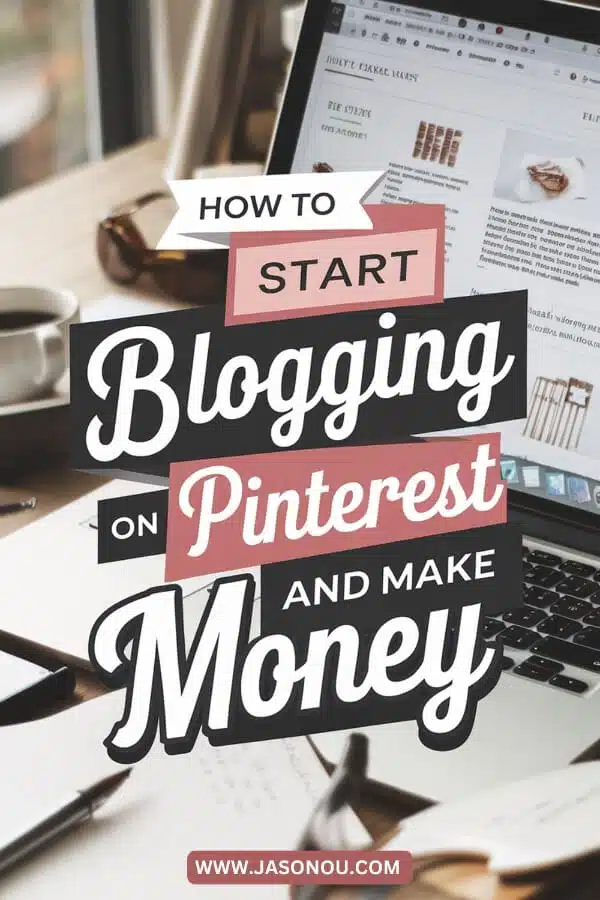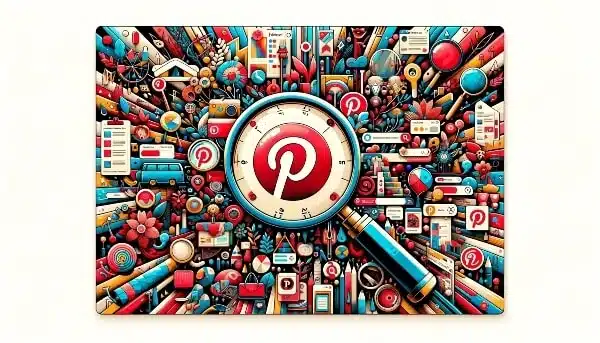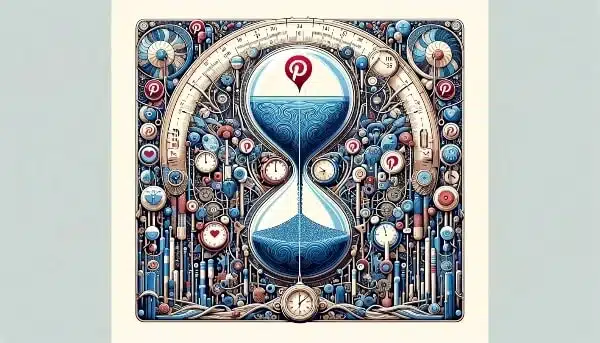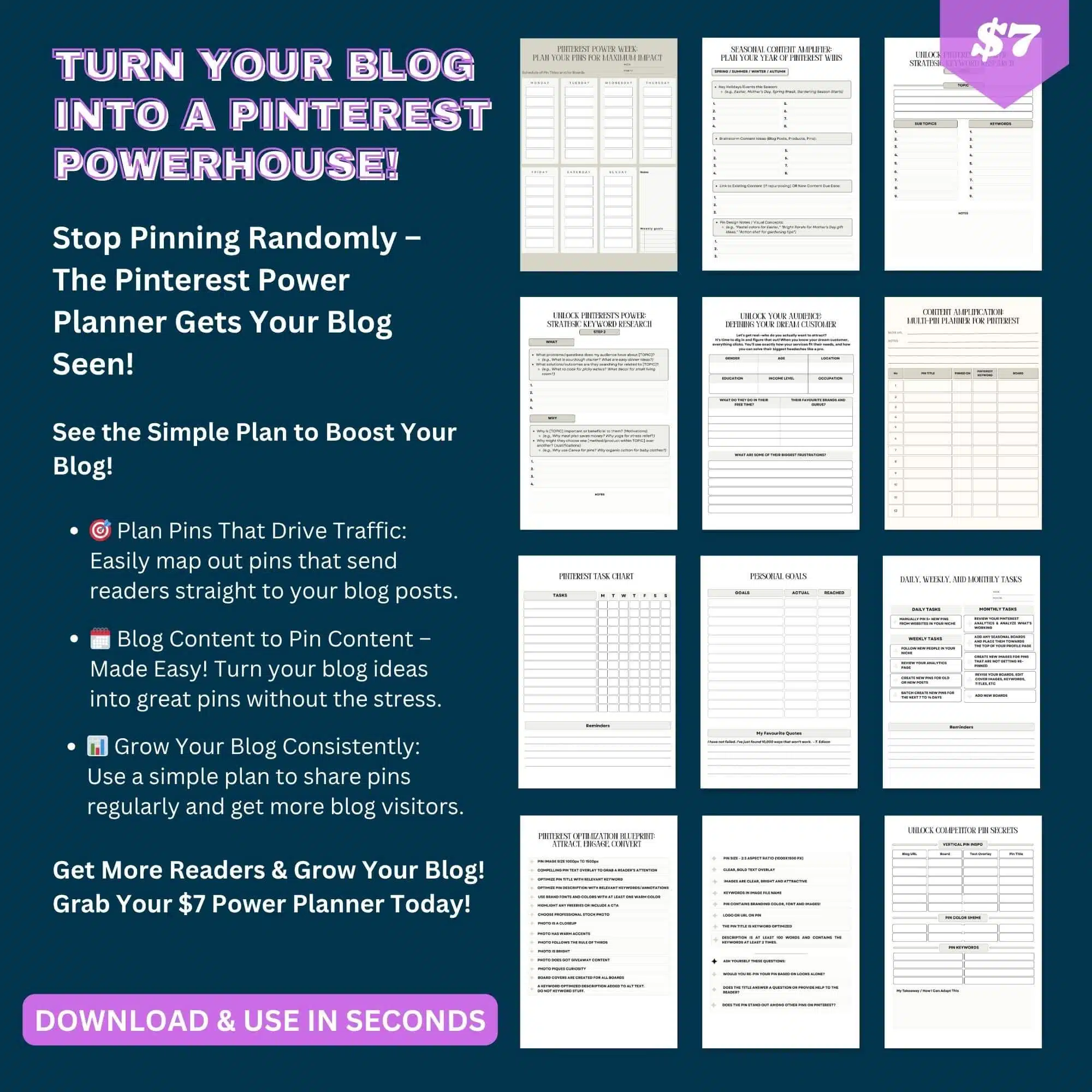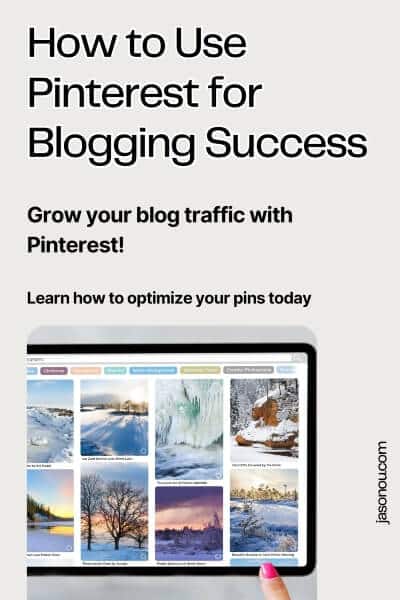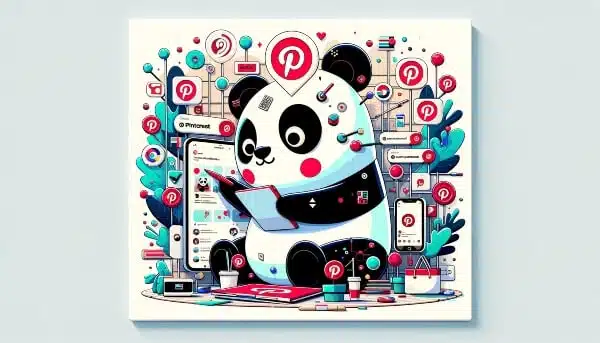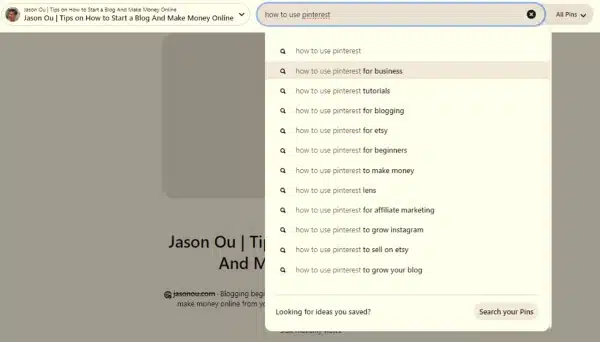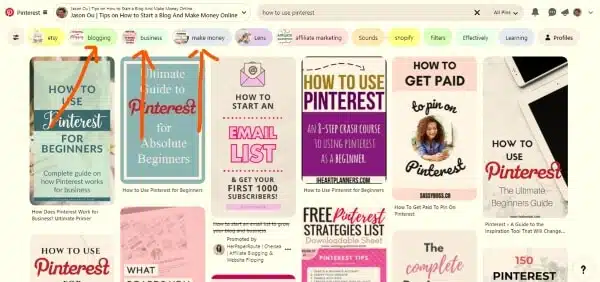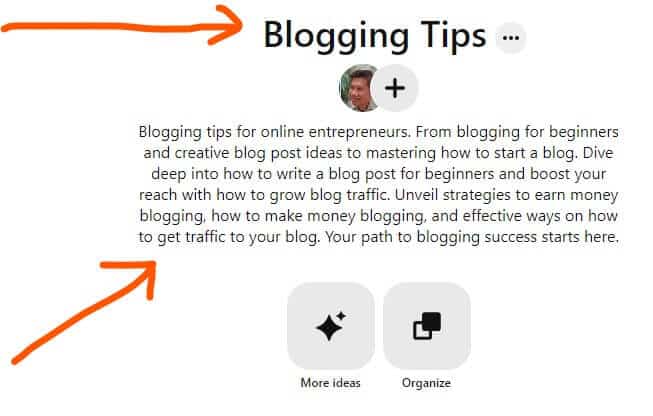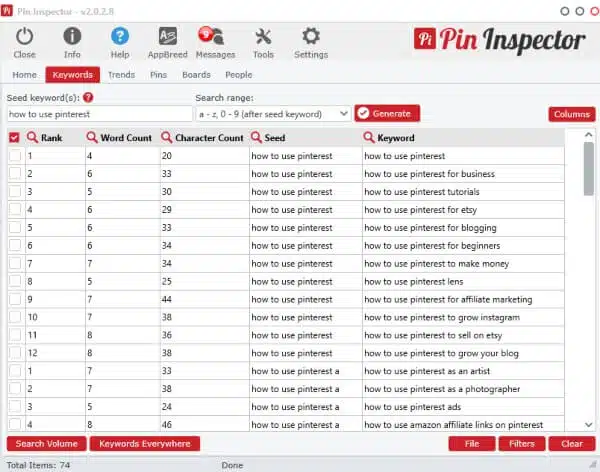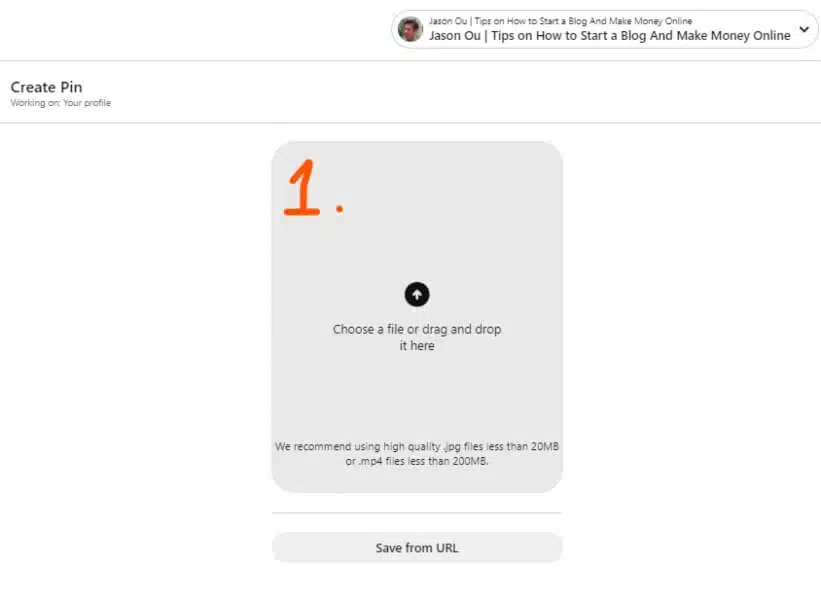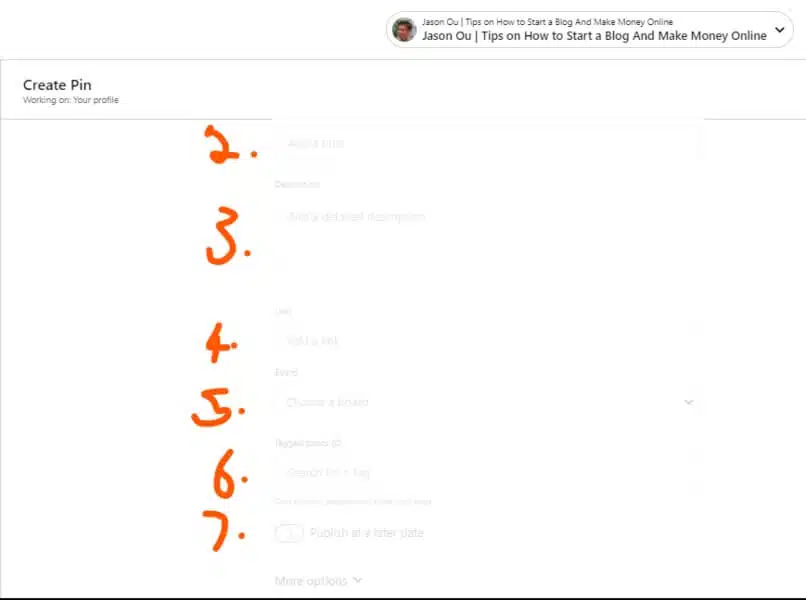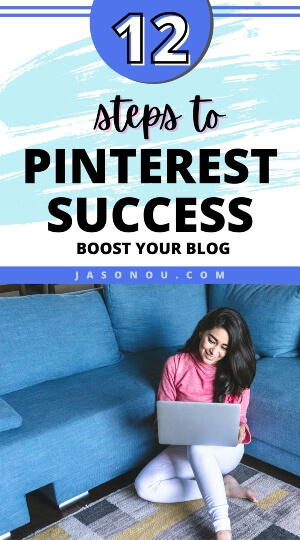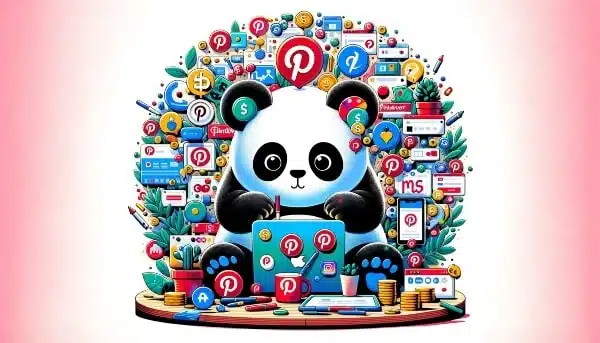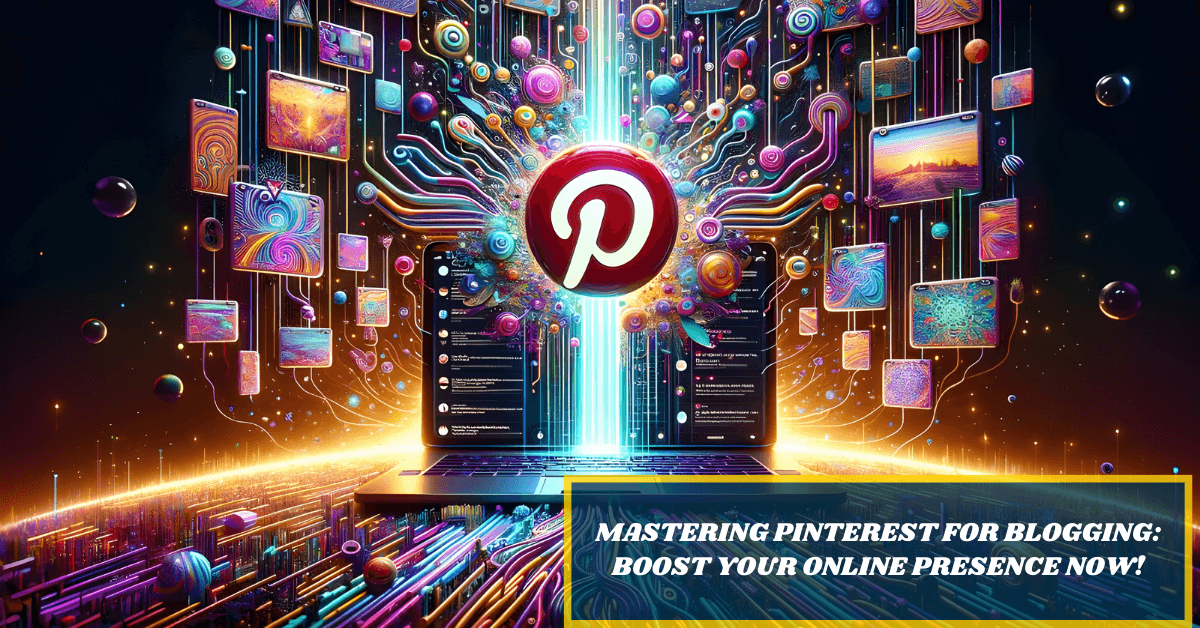Struggling to get eyes on your blog? Pinterest can help … big time.
It’s not a social app. It’s a traffic tool.
People use it to search, save, and click.
That’s where your blog comes in. This guide breaks down how to use Pinterest for blogging in 12 simple steps.
No tech skills needed.
No big budget.
Just smart moves that get results.
If you want to grow your blog without feeling lost, keep reading.
You’re about to learn a game-changing strategy.
So let’s look at how to start a Pinterest blog, and use Pinterest to grow your blog.
Ready to Learn How to Start a Blog on Pinterest? Jump to Step 1 Here and Skip the Pinterest Blogging Intro.
Key Takeaways
- Start Smart: Set up a Pinterest Business Account to unlock tools like analytics and ads. And make sure your blog has some posts before you begin pinning!
- Design to Stand Out: Use tools like Canva to make pins with bold images and clear text. Always link your pins back to your blog to get more traffic.
- Be Search-Friendly: Add keywords to your profile, boards, and pin descriptions so people can easily find your content when they search.
- Pin New Posts Fast: Share each new blog post on Pinterest right away. Save the pin to the most relevant boards first for the best reach.
- Work With the Algorithm: Pinterest likes quality. Focus on good blog content, helpful pins, and the right keywords to get noticed.
- Pin Often: Share your own blog posts regularly. Create a few different pins for each post to boost visibility.
- Track & Automate: Use Pinterest Analytics to see what’s working. Save time by scheduling your pins with tools like Tailwind.
Save/Pin the image below👇because I often update my posts. So stay informed with this blog “How to Use Pinterest for Blogging” and save it.
This page have some affiliate links. In other words, if you buy from my links, I may get a commission. And some of the images were sources from Unsplash+ (Rodion Kutsaiev).
Ready to Learn How to Start a Blog on Pinterest? Jump to Step 1 Here
Understanding Pinterest’s Role in Blogging
You’ll be surprised that…
Pinterest is a Visual Search Engine
Pinterest is not a social media platform. It is a search engine for images.
People use Pinterest differently than other social sites. They don’t go there to talk or discuss photos.
Instead, they look for new ideas, inspiration, and tips.
Hence, it’s a visual search engine.
This makes Pinterest a great tool to get more eyes on your blog posts.
You see, when you use the right keywords in your pin descriptions, it’s easier for Pinterest users to discover your content.
They’re looking for what you’re sharing!
So, the key thing you need to learn is how to pick the right keywords to use on Pinterest.
A lot of new bloggers miss this.
They think they should just hang out on Pinterest and chat with people.
But when they don’t see any good results, they get frustrated and quit.
I don’t want you to end up like that.
Here’s what you should do instead:
Think of Pinterest like Google. But on a smaller scale.
To do well on Pinterest, you need to use it like it’s a search engine.
So, think of each keyword optimized pin as a mini-advertisement for your blog post.
An eye-catching image can make someone stop scrolling and take notice.
And if they click through, boom.
They land right on your site!
That’s why mastering how to use Pinterest correctly can boost traffic to your blog in big ways.
However. Pinterest for blogging does take time to generate traffic.
So stick to a strategy and pin consistently.
By the way👋, if you need help with help to start a blog on Pinterest, you can reach out to me here.
Long lifespan of Pins
Pins on Pinterest stick around for a long time.
They don’t just disappear after a few minutes like tweets or Facebook posts.
Imagine posting something and having it seen and shared for days, weeks, or even months later.
That’s how it works with pins.
They have a lifespan of one week!
This means your content keeps working for you long after you’ve pinned it.
With such staying power, each pin can guide more eyes to your blog over time.
In fact, most Pinterest users let pins help them decide what to buy.
So if you’re sharing great stuff related to what folks want, there’s a big chance they’ll come looking at your blog too.
It’s like planting seeds that grow into a garden of traffic coming right to you!
Traffic growth potential with Pinterest
When done right, Pinterest can skyrocket your blog’s traffic.
This social platform works like a search engine.
So people can find and share your content even months after you pin it.
Unlike other platforms where posts get buried quickly, pins continue to bring visitors to your site over time.
You put in the work once and reap the benefits for much longer.
Now let’s talk growth.
Pinterest is behind only Facebook when it comes to driving folks to websites. That means more eyes on your blog posts.
By using Pinterest marketing strategies and keyword research, you’re not just tossing out content into the void.
Just for easy reading, below is a table summary of why you should use Pinterest.
Want to know How to Use Pinterest for Blogging? Jump to Step 1 Here
| Feature | Description |
|---|---|
| Visuals are key | Pinterest is all about images and visuals, perfect for showcasing products or ideas in an appealing way. |
| Search engine-like | Users search for inspiration on Pinterest, making it a great place for your pins to be discovered if they match popular search terms. |
| Long-lasting content | Pins on Pinterest have a longer lifespan compared to other social media posts, allowing your content to be discovered and re-pinned over time. |
| Links back to your site | Every pin can link back to your website, driving traffic to your site whether it’s a blog post, a product page, or any other content. |
| Ready-to-buy audience | Many users on Pinterest are looking for ideas with the intent to purchase, providing a great opportunity to reach potential customers at the right moment. |
| Keywords are crucial | Using the right keywords in your profile, pin titles, pin descriptions, board names and board descriptions can help your content get found. Think about what terms your audience might use to search. |
Table 1. Summary of the key features of Pinterest’s role in blogging.
With that said, here’s how to start a Pinterest blog.
Real Quick
Pinterest is amazing for bloggers, but feeling a bit lost on how to plan all your pins to get those readers?
There’s an easy way to fix that!
How to Use Pinterest for Blogging in 12 Steps
👋Save/Pin the image below ☝️☝️☝️to read again.
After your blog is up and running, you can make a Pinterest business account for free.
This account will be your key tool for sharing and promoting your blog posts!
But, hold off on making this account if your blog doesn’t have 10-15 articles up yet.
It’s important to have your blog filled with some content first before you get your Pinterest business account, as Pinterest will need your blog’s link.
And with lots of content at hand, you can make three or more pins for every blog post.
This helps you stay active on Pinterest. Consistently.
Here’s how to use Pinterest to drive traffic to your blog in 12 key steps.
- Start a Pinterest blog
- Setting up a Pinterest Business account
- Claiming your business account website
- Pinterest keyword research
- How to use keywords on Pinterest
- How to get traffic from Pinterest to your blog
- Share new posts on Pinterest immediately
- Save new pins to the most relevant board first
- Create multiple pins for your blog post
- Tracking your best performing pins
- Automate your pinning
- How to use Pinterest to make money blogging
1. Start a Pinterest Blog
The first thing you need to do is start a blog! 🙂
You need a blog to start with.
If you’re new and not sure how to begin, don’t worry, I’ve got you covered.
I’ve helped lots of people start blogs, and you can reach out to me here for a consult.
It’s really cheap to start, just US$2.95 a month if you choose the yearly plan, which only costs $36 upfront!
Just a heads up, even though you want to know “how to start a blog on Pinterest,” it is not about making a blog directly on Pinterest.
What you actually do is set up a blog with a hosting service, like Bluehost, and then connect your blog to Pinterest.
(For only $2.95*/month, it’s a tiny investment for building an asset)
This way, you can share your blog posts on Pinterest and use it to get more visitors and make money online.
Here’s a complete guide I covered on how to start a WordPress blog on Bluehost.
2. Setting up a Pinterest business account
We know starting a Pinterest business account is the first step to grow our blog.
It unlocks powerful tools like analytics and ads that are essential for any blogger.
So let’s look at how to start a Pinterest business page below.
- Head over to Pinterest and find the “Sign up” button.
- Choose “Create a business account“.
- Fill in the details for your business, including email, password, and age.
- Click on “Create Account” to proceed.
- Add your Profile Details, like your name and a picture of yourself or your logo.
- Explain what your brand or blog is about in the “About your profile” section. ✅Keep it short but sweet, using keywords that relate to your blogging niche. (More on this later.)
- Under “Claimed Accounts“, connect and you social accounts. (More on this shortly.)
- Verify all details are correct and hit “Next“.
- Set up advertising if you’re interested in promoting pins right away—this step can be skipped for now.
- Install the Pinterest tag on your blog to track actions visitors take—it helps with targeted ads later.
- Make sure to claim your website by adding an HTML tag or uploading an HTML file to your website’s root directory for verification.
3. Claiming Your Business Account website
Claiming your business account website on Pinterest is a smart move for blogging beginners.
This is a must.
It opens the door to analytics and marketing tools that can help grow your blog.
- First, set up a Pinterest business account if you haven’t already. This gives you access to special features meant for businesses.
- Visit the settings section of your Pinterest account. Look for the “Claim” option.
- Choose “Claim website” and enter your blog’s URL into the space provided.
- You will see several options to verify your site, like adding an HTML tag, uploading an HTML file, or updating your DNS records.
- If you’re familiar with HTML, choose the meta tag method. Copy the provided meta tag and paste it into the section of your blog’s homepage.
- For those using WordPress, plugins like Yoast SEO make it easier. Just paste the meta tag into the appropriate section in the plugin.
- Alternatively, download an HTML verification file from Pinterest. Upload this file to your blog’s web server via FTP or through your hosting provider’s control panel.
- After adding the tag or uploading the file to your blog, go back to Pinterest and click “Verify“.
- Once verified, you’ll see a checkmark next to your website in settings. This confirms that you’ve successfully claimed it.
Still unsure? Here’s a 5-step beginner’s guide I wrote on how to claim your website on Pinterest.
4. Pinterest Keyword Research
Think of Pinterest as a big search engine. People use specific words and phrases to search for content they find interesting.
Once you begin pinning, Pinterest starts to get a sense of what you’re interested in.
It looks at what you pin, who made those pins, and how you discovered them.
Pinterest has one main goal as a search engine:
It aims to give you the best and most relevant results for whatever you search for.
Better search results make users happy, and happy users tend to stick around longer.
That’s what any website, including Pinterest, wants.
The Pinterest algorithm is always on the lookout for new content that it thinks you might like.
As you pin more, Pinterest figures out what to show you.
Take your home feed, for instance. It’s filled with pins Pinterest believes you’ll enjoy.
And for each of your boards, there’s a “More ideas” section with related content.
Got lots of great ideas for using Pinterest for your blog, but not sure how to organize them into a real plan that brings visitors?
Let me show you something helpful…
So, how does all this tie into your Pinterest strategy?
Why do keywords matter so much on Pinterest?
When you post a new pin, Pinterest has to work out:
- Who should see this pin?
- When should it show up in searches?
- When should it show up alongside related pins?
We might not have all the details on how Pinterest’s algorithm ticks.
But it’s good to be aware of the behind-the-scenes action when you’re sharing your blog posts on Pinterest.
You need to make it easy for Pinterest to understand what your pin is about. This is where keywords come into play.
Keywords are crucial because they’re how Pinterest decides when and where your pins should appear.
How to Find Keywords For Pinterest
The quickest way to discover top keywords is by using Pinterest’s search bar.
Just like Google search bar, you’ll get ideas on what people are searching about. Automatically.
There are 2 areas where you can find Pinterest keywords.
First, when we input “How to Use Pinterest“:
Image 1a: Pinterest search bar providing Pinterest keyword ideas.
Image 1b: Search bubbles show you the top top trending searches on the Pinterest at the moment.
Notice how the search offers related, more specific keyword suggestions? Like …
- How to use Pinterest for Business
- How to use Pinterest for Blogging
- How to use Pinterest for Beginners
More Pinterest blogging ideas.
These are valuable Pinterest keywords that can lead you to more precise, long-tail search terms that people are using.
(Long-tail keywords are less competitive😉)
Pinterest keyword research is pretty straightforward.
Just jot down your keywords and organize them into logical categories, maybe in a Google Sheets document.
Now that you’ve got your keywords, let’s look at how to get blog traffic from Pinterest.
5. How to Use Keywords on Pinterest
It’s important to spread your keywords throughout Pinterest, but they need to be part of a clear plan.
Just throwing keywords everywhere can mess up your strategy.
Knowing where and how to use keywords is key for good Pinterest SEO.
Place them thoughtfully in the following areas:
- Pinterest Profile:
To make it easier for people to find you on Pinterest, set up your profile with keywords that match your blog’s topic. Go to the Settings in the menu at the top right of your Pinterest home page.Include one or two keywords that relate to your area of expertise in your profile name, and add some more in your About section.This can really boost your visibility on Pinterest.
- Board Titles and Descriptions:
Make your board names short and name it using one main keyword.When writing board descriptions, include related keywords to help Pinterest categorize your pins correctly.For example, if you run a blog about gardening and you have a section for container gardening vegetables ideas, name your board exactly that: “Container Gardening Vegetables Ideas”.
It’s clear and to the point.
Skip the fancy names like “Let’s Grow It!” or “Veggies to Grow” since people aren’t likely to search for those terms.
- Text Overlays on Pins:
Use text on your pin images to clearly explain what your pin is about. Tools like Canva make this easy. - Pin Titles and Descriptions:
Pick keywords that fit your pin and use them in your titles and descriptions, but keep it natural and don’t overpack with too many keywords. - Keywords in Blog Posts:
When you link a pin to your blog post, Pinterest does crawl your blog URL. So be sure to include keywords that match the Pinterest board theme.
Note: Using keywords should feel natural, not forced.
They should be directly related to your content, like sticking to the topic in small backyard garden vegetable planter boxes without drifting off into general gardening terms.
Image 2: How to use Pinterest effectively – Apply Pinterest SEO by adding keywords to both in board titles and board descriptions.
6. How to Get Traffic From Pinterest to Your Blog
Ready to learn how to use Pinterest to grow your blog?
Once your Pinterest is ready with profiles and boards, it’s time to add pins that look good and bring people to your website or blog.
The goal is to make pins that make people want to click on them for more page views, email signups, or comments.
You don’t have to be a pro at design to make great pins. I’m not.
Tools like Canva are free and easy to use, and they have everything you need to make your pins stand out.
With that said.
To make a Pinterest pin that really takes off, it’s crucial to understand what your blog’s audience is looking for on Pinterest.
What problems are they looking to fix?
Here are some top tips for making your next pin image stand out & get traffic to your blog:
- Text Overlay:
Use text on your images to highlight the main benefit of your blog post and grab attention. (Don’t forget to include your keyword) - Add a Logo or Blog URL:
Include a small branding element on your pins, either at the top or bottom, to make them look consistent. - Image Size:
Opt for vertical images with a 2:3 aspect ratio, like 1,000 x 1,500 pixels, as they work best on Pinterest. - Compelling Images:
Although premium stock photos are recommended. You could start with free stock photos from sites like Unsplash or Pexels to make your pins stand out. - Sidenote … Keyword your Image File Name:
Name your pin image like this: how-to-use-pinterest-for-beginners.PNG, NOT pinterest-image.PNG
Now that you have pin image checked, let’s look at how to increase Pinterest traffic with optimizing your Pins.
By the way👋, if you need help with help to start a blog on Pinterest, you can reach out to me here.
Optimizing Your Pinterest Pins
To make sure your pins get noticed, focus on two things.
- Add keywords to your pin title (keep it under 100 characters);
- Add keywords in your pin description (no more than 500 characters).
It’s a short list, but super important for driving Pinterest traffic your way.
So here’s an example of how to Pinterest SEO a pin title & description for this blog post (How to Use Pinterest for Blogging) you’re reading.
- 💥Pin title:
How to Use Pinterest for Blogging in 2025 - 💥Pin description:
Master how to use Pinterest for blogging and transform your blog’s reach. This guide is perfect for how to use Pinterest for beginners, offering step-by-step strategies to captivate and engage your audience. Discover how to use Pinterest to drive traffic to your blog, turning pins into page views. Check out these simple tips to help your posts stand out.
Keywords are bolded for your reference.
Note: To SEO a Pin description, begin with your main keyword, then include similar words and all other important keywords you find from your research.
By the way.
I found the keywords using Pin Inspector😉: (See how the keywords are the same as Image 1.)
Image 3: Pinterest keyword ideas generated by Pin Inspector.
There are other ways to find keywords on Pinterest, like the ads section’s keyword tool, but it can be a lot of fuss.
Using a paid keyword tool can save you time and hassle.
Use tools like the Pinterest search bar or Pin Inspector to find those Pinterest keywords.
Pin Inspector is great for finding keywords on Pinterest. It costs $67, but you can get $20 off when you click here. It offers lots of detailed information on popular keyword search terms and more. While it might look complex at first, it’s easy to use once you get the hang of it.
Then write a benefit driven description for the readers.
Always include words that spark interest or emotion.
Words like ‘effortless,’ ‘transform,’ or ‘secrets’ can work wonders.
It’s all about packaging the value of your blog post into one tempting teaser that makes someone want to learn more.
How to Upload Pins on Pinterest
Once you’ve written your first 5 to 10 blog posts and created eye-catching Pins for each, upload these Pins to your Pinterest.
By linking each Pin to its corresponding blog post, you’ll start drawing visitors to your blog.
How to Pin in Pinterest
Here’s a brief guide on connecting your blog posts to Pinterest to increase blog traffic:
Step 1. Sign in to your Pinterest business account.
Step 2. Navigate to “Create” and select “Create Pin“
Step 3. Choose the Pin image you’d like to use and upload it. For those using Canva, you can directly download your Pin designs from there.
Check out the screenshot below for a visual guide on how to link your blog posts to Pinterest:
- Select your desired Pin image from your device.
- Enter a catchy title in the title field, including relevant keywords.
- Write a descriptive Pin description, including relevant keywords.
- Paste the URL of the blog post you’re linking to.
- Pick the Pinterest board you want your Pin to appear on.
- Add your tags that are relevant to your blog post
- Decide whether to publish immediately or schedule for later.
Image 4a – How to upload pins on Pinterest, Step 1
Image 4b – How to upload pins on Pinterest, Step 2 to Step 7.
Need help? Use Pinterest templates to save heaps of time
Making beautiful Pinterest images that grab attention can be time-consuming, and not everyone has the hours to spare. I’ve been there.
Plus, thinking of new, catchy pin designs can be tough.
But there’s a quick way to make lots of great-looking pins fast – grab these eye catching Pinterest Template bundle for Canva.
These templates are great because they let you quickly make lots of great-looking pins.
(Below👇 is a pin I created using one of the Pinterest templates. It was easy to use and edit on Canva. A BIG time saver.)
And the best part? They’re totally free to use and edit on Canva here.
While you’re at it. Save/Pin the image below👇, so you can refer back to this guide on “How to Use Pinterest for Blogging“. So save it now.
7. Share New Posts on Pinterest Immediately
As soon as your blog post goes live, head over to Pinterest and share it.
This quick action helps you catch the wave of the Pinterest algorithm that loves fresh content.
Create a new pin, add a catchy image, and write a clear description with relevant keywords.
The sooner you pin, the faster you tap into potential traffic.
Pins on Pinterest last longer than on other social media platforms.
This means more chances for people to find your posts days, weeks, or even months later.
So don’t wait.
Get your newest blog entry onto Pinterest right away!
Use bright pictures and easy-to-read text that tells viewers what they’ll gain by clicking through to your site.
Keep feeding Pinterest’s hunger for new pins and watch as it feeds traffic back to your blog.
8. Save New Pins to the Most Relevant Board First
Think about where you save your pins like choosing the right folder for a file.
You want people to find it easily. So, put your new pin on the most relevant board first.
This helps a lot because Pinterest sees this and knows what your pin is about.
It can then show it to others who are looking for that kind of thing.
Let’s say you wrote a blog post about easy cake recipes.
You’ve made a bright, yummy-looking image for Pinterest too!
Now, don’t just put it anywhere.
Add it to your ‘Delicious Dessert Recipes’ board where all things sweet belong.
That way, when folks search for cake ideas, they might stumble upon yours and visit your blog to learn more!
Remember to.
Save only relevant content to each board.
9. Create Multiple Pins for Your Blog Post
Look. It’s totally fine if you can’t put out a new blog post daily or weekly.
Instead, you can keep things fresh by making new pins for your older posts.
This works really well for content that stays relevant over time, helping you get more eyes on your articles with new pin designs.
How Many Pins Should I Make for Each Blog Post
How many pins to make for one blog post isn’t clear-cut. It varies.
I typically go for 5 designs per post to test which style gets more attention.
(Be sure that each pin has a different design, different title and different description)
If a design does well, I might make 2 or 3 more like it a month later and keep going if those are hits too.
You don’t need tons of pins per post.
Starting with a few to test the waters is fine.
When you figure out what your audience prefers, you can lean into that style with new pins.
Keep an eye on Pinterest Analytics to see which pins are doing the best.
How can you save a lot of time with this trick?
My schedule is usually packed, so I keep a set of easy, attractive Pinterest templates on Canva handy.
This way, when I need to make a bunch of new pins, I can just tweak these templates for a particular post and get them up on Pinterest in no time.
10. Tracking Your Best-Performing Pins
Use Pinterest Analytics for this. It’s like a super tool that tells you which of your pins people love most.
Look at the numbers and see what works.
Which pins get saved a lot? What images or words are making people click?
✅Find out and make more like those.
Your top pins can teach you lots about your pinning strategy.
They show what topics or styles are hits with your audience. Use that info!
Create new content that matches these winners.
This way, you keep giving your followers what they enjoy, and they’ll come back for more!
But don’t stop there. Use Google Analytics too.
It’ll help track visitors from Pinterest to your blog posts. And isn’t that the goal?
More eyes on your amazing work!
Keep tracking often. It helps you stay on top of the game.
Don’t Miss This:
11. Automate Your Pinning
If you’re just starting with your blog and Pinterest, you’re doing a lot.
Like, brainstorming on what to blog, writing, social marketing, working on the SEO, and staying on top of email marketing.
Wouldn’t it be nice to pass off some tasks, especially ones that could be done by a software, right?
Pin on Autopilot
To boost your blog traffic with Pinterest without adding extra work to your day, consider using a scheduling tool.
This tool can automatically post your content at the best times, even when you’re not awake.
Best Pinterest Scheduler Tool
There are some handy tools for automating your Pinterest activities, and from my own experience, I recommend Tailwind.
Here’s how it simplifies your pinning process:
Set Up a Pinning Schedule: You decide how often you want to pin each day, and Tailwind picks the best times for your pins to be seen by more people.
Fill Up Your Pin Queue: You can upload your own pin images to Tailwind or choose pins right from Pinterest to add to your schedule.
Automate Your Pinning: Once you’ve set your schedule, Tailwind takes over and posts your pins at the optimal times, freeing you up to focus on other tasks.
Click here to start using Tailwind for free.
Increasing Engagement with Tailwind Communities
I love diving into Tailwind Communities.
They’re like clubs for people who dig the same stuff I do.
We all share our pins there, and it’s super cool seeing your content get love from others who are just as passionate.
It’s a big win-win.
My stuff gets out there more, and I find awesome ideas to spice up my own boards.
Joining these groups is easy, and they save me a ton of time.
Instead of posting one pin at a time, Tailwind lets me schedule a bunch to go live when folks are most likely to see them.
And guess what?
People in these communities actually want to see what I’ve shared because we’re all into the same thing!
It feels great getting noticed by users already interested in my niche.
12. How to Use Pinterest to Make Money Blogging
Eager panda learning how to use Pinterest for blogging and monetization.
You’ve got traffic flowing from Pinterest blogging, great!
Now let’s talk making money.
Start by creating pins that lead to blog posts where you can lead them to an affiliate link, a service or an email sign up.
(This is really how to use Pinterest for blogging)
I’m not going to go deep in this section, as I’ve covered this extensively on How Do Bloggers Make Money.
But here are 4 simple ways to make money pinning on Pinterest.
1. Display Advertising
One way to earn money through your blog is by placing ads on it. You’ve likely seen these types of banner ads on various websites.
Companies like Mediavine and AdThrive pay you for every thousand times their ads are seen or clicked on your blog.
Making money through ads is profitable but needs a lot of website visitors to work well.
If you’re starting out, Google AdSense is a good choice because it’s popular and easy to use.
However, you might find that the earnings from Google AdSense aren’t as high as you’d like.
Working with other partners, like Mediavine can potentially increase your earnings.
Starting with display ads is a good, simple way to begin making money with Pinterest blogging.
However, it won’t be easy.
But, it helps blogging beginners understand how to earn online without getting too complicated.
It’s a good idea to focus on getting really good at one thing before you try to learn other ways to make money.
2. Affiliate Marketing
Affiliate marketing is a simple way for beginners to earn money by recommending other people’s products.
You just place links to these products on your blog or website.
If someone makes a purchase through your link, you get a piece of the sale as a commission.
(But, be sure to declare this on your blog.)
This method is particularly appealing for newcomers since it doesn’t require you to have your own products.
There are many online affiliate programs you can join.
Just pick the ones that match what you’re interested in and start sharing their products.
Popular ones include Amazon Associates, Clickbank, CJ and ShareASale. Just to name a few.
You can sign up for most of these programs easily.
After joining an affiliate program, you can share product links in your blog and on Pinterest.
If someone buys through your link, you get a commission.
But, making sales through affiliate links isn’t just about posting links everywhere.
You need a good plan and should only promote products that fit your audience’s interests.
With the right approach and learning, you can become good at affiliate marketing on Pinterest.
3. Consulting or Coaching Programs
You can make money through your blog by offering consulting or coaching.
If you’re good at something you love, you can help others reach their goals and charge well for your expertise.
It’s why I offer consulting services.
They’re a great way to make money with a blog. If I’m an expert at something, I can help others reach their goals too.
For example, if someone’s good at social media strategy or SEO expert tricks, they could teach those skills through a program.
Consulting means giving one-on-one advice. Coaching is more like teaching a group of people in sessions
Both ways are powerful for helping folks and making your blog profitable.
4. Sell Services or Products
You can also make money by selling things like e-books, online courses, or physical items on your blog. Once you start getting visitors from Pinterest, you can offer these products or services.
How to Use Pinterest for Blogging Beginners FAQ
Got questions buzzing in your head about Pinterest and blogging?
Is Pinterest Good for Blogging?
Pinterest shines for blogging. Think of it as a search engine where people look for ideas and inspiration.
If you blog, Pinterest can send loads of visitors your way. Imagine reaching over 480 million users each month who are eager to explore what you have to offer.
You post great images linked to your blog articles on Pinterest boards.
Then, those hungry for content like yours see them. They click, they read, and hey—they might just fall in love with your blog!
It’s a win-win: you help them find what they’re looking for and drive traffic that ramps up over time back to your site.
Plus, after Google, it’s ranked the second-best at sending folks over to websites just like yours.
How to Link Blog Posts to Pinterest?
Linking your blog posts to Pinterest is like opening a door to more readers.
First, make sure you have a business account. It’s free and unlocks cool features.
Then, create an eye-catching image for your post; this will be your pin.
Use tools like Canva if you need help designing.
Now it’s time to add the new pin to one of your boards. Click that red “plus” icon on Pinterest, select ‘Create Pin,’ and upload your image.
In the description box, write something tempting about what they’ll find in the blog. Use keywords!
Don’t forget; this helps people discover your pin when they search.
Finally, paste the direct link to your blog post in the spot labeled ‘Destination Link.’ Hit save, and voila!
Your blog now has a pathway straight from Pinterest, leading folks right back to all those awesome words you wrote.
Keep creating pins for each post you publish and create multiple pins for each blog.
How Do Bloggers Make Money on Pinterest?
Making money on Pinterest is all about getting people to click through to your blog.
Once they’re there, you can show them ads, link them to products, or offer services.
Think of it like a colorful billboard that grabs attention on the highway. Except this highway is online and full of potential clicks!
You set up eye-catching pins that lead back to your website where you’ve got different ways to earn cash waiting.
Let’s say you put together an awesome post with affiliate links.
You craft a pin that makes someone think, “I need to read this”!
They click over from Pinterest because your image stands out and your description promises value.
Now they’re on your page, and if they buy something through one of those links, cha-ching—you earn a commission!
Or maybe companies pay you for posts since you bring in so much traffic from Pinterest; that’s another way bloggers get their hustle on.
It’s about being smart with how we use our images and words to turn pins into profit.
Can Pinterest really boost my blog’s traffic?
Absolutely! By creating eye-catching pins and using keywords, you can drive more people to your blog through Pinterest. It works like a charm for many bloggers.
Should I use specific hashtags on Pinterest?
Yes, you should! Hashtags help others find your content easily on this social platform—just like they work on Twitter and Instagram. Keep them relevant and not too spammy, alright?
How do I make my pins stand out?
Add bright images and engaging titles with a call-to-action—you’ll catch their eyes in no time! Also, make sure it’s user-friendly so anyone can enjoy what you’ve created.
Do I need to understand SEO for Pinterest?
Well, yes—it helps a lot! Understanding search engine optimization or SEO pushes your pins higher in searches; just don’t overdo it with keyword stuffing.
What’s the best way to link my YouTube videos to Pinterest?
Create a pin that includes an image from your video; then, add the direct link to your YouTube channel right there! This way folks can click straight through—easy peasy!
Is there any special code I should add to my blog for Pinterest success?
You betcha! Use the ‘Save’ button meta tag from Pinterest or tools like Yoast SEO on WordPress sites which helps integrate with social networks including… drum roll…Pinterest!
How to use Pinterest for Blogging : The Wrap
You’ve learned the steps to take your blog higher with Pinterest.
It’s like a secret path to more readers and fans! Stick with it, stay creative, and watch your blog grow.
Remember, using Pinterest for blogging is all about having fun and sharing your passion.
Now go pin some great stuff – you got this!
By the way👋, if you need help with help to start a blog on Pinterest, you can reach out to me here.
Disclosure: This post may contain affiliate links, which means I’ll receive a commission if you purchase through my links, at no extra cost to you. Please read full disclosure for more information.
You Might Want to Check This Out Too
Resources To Grow Your Business With
Pinteresting
Struggling to get traffic from Pinterest? Pinteresting Strategies 2025 by Carly Campbell reveals a manual pinning method that works—even with algorithm changes.
This course walks you through step-by-step strategies to pin effectively, increase engagement, and grow your blog without relying on expensive schedulers.
Carly has used this exact system to bring in 100,000+ page views in just months, and now she’s sharing it with you.
Stop guessing and start seeing real results today!
Bluehost
Bluehost is a great starting point for beginners or bloggers who want to switch to a reliable web hosting service. And it gives you the best bang for your buck - starting at $2.95 a month*.
With the entry-level hosting plan, you'll get a high up-time, reliable customer support, FREE domain name (first year) and 30 day money back guarantee.
You can sign up with Bluehost here.
WPX Hosting
It's a web-hosting service I love using. It specializes in WordPress hosting, and depending on what package you opt for, you can host 5 or more sites on one account. The best bit is - the quick turnaround in support is top notch.
For bloggers who have an established blog, this is a fantastic option.
You can learn more about this service here.
Aweber
Building an email list of a growing audience is essential for the longevity of any business. This autoresponder service is easy to use, and it is a great starting point for someone looking to kickstart their email campaign.
Hi, I’m Jason Ou (surname aka, Oh). I am a Solopreneur and Blogger. My mission is to help fellow entrepreneurs (like you) to profit from their passion online. Let’s connect on Facebook now.
